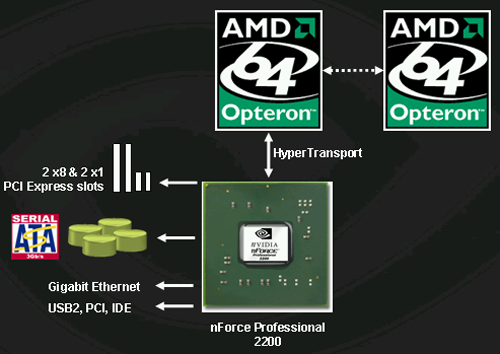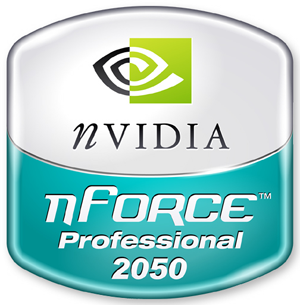NVIDIA nForce Professional Brings Huge I/O to Opteron
by Derek Wilson on January 24, 2005 9:00 AM EST- Posted in
- CPUs
NVIDIA nForce Pro 2200 MCP and 2050 MCP
There will be two different MCPs in the nForce Professional lineup: the nForce Pro 2200 and the nForce Pro 2050. The 2200 is a full-featured MCP, and while the 2050 doesn't have all the functionalty of the 2200, they are based on the same silicon. The feature set of the NVIDIA nForce Pro 2200 MCP is just about the same as the nForce 4 SLI and is as follows:
- 1 1GHz 16x16 HyperTransport Link
- 20 PCI Express lanes configurable over 4 physical connections
- Gb ethernet w/ TCP/IP offload Engine (TOE)
- 4 SATA 3Gb/s
- 2 ATA-133 channels
- RAID and NCQ support (RAID can span SATA and PATA)
- 10 USB 2.0
- PCI 2.3
The 20 PCI Express lanes can be spread out over 4 controllers at the motherboard vendor's discretion via NVIDIA's internal crossbar connection. For instance, a board based on the 2200 could employ 1 x16 slot and 1 x4 slot, or 1 x16 and 3 x1 slots. It cannot host more than 4 physical connections or 20 total lanes. Technically, NVIDIA could support configurations like x6 which don't match PCI Express spec. This may prove interesting if vendors decide to bend the rules on anything, but likely server and workstation products will stick to the guidelines.
Maintaining SATA and PATA support is a good thing, especially with 4 SATA 3Gb/s channels, 2 PATA channels (for 4 devices), and support for RAID on both. Even better is the fact that NVIDIA's RAID solution can be applied across a mixed SATA/PATA environment. Our initial investigation of NCQ wasn't all that impressive, but hardware is always improving, and applications in the professional space are a good fit to NCQ features.

This is the layout of a typical system with the nForce 2200 MCP.
The nForce Pro 2050 MCP, the cut down version of the 2200 that will be used as an I/O add-on, supports these features:

- 1 1GHz 16x16 HyperTransport Link
- 20 PCI Express lanes configurable over 4 physical connections
- Gb ethernet w/ TCP/IP offload Engine (TOE)
- 4 SATA 3Gb/s
Again, the PCI Express controllers and lanes are configurable. Dropping this down to add those plus another GbE and 4 more SATA connections is an obvious advantage, but there is more.
As far as we can tell from this list, the only new feature introduced from nForce 4 is the TCP/IP offload Engine in the GbE. Current nForce 4 SLI chipsets are capable of all other functionality discussed in the NFPro 2200 MCP, although there may be some server level error reporting built into the core logic of the Professional series that we are not aware of. After all, those extra two million transistors had to go somewhere.
But that is definitely not all there is to the story. In fact, the best part is yet to come.










55 Comments
View All Comments
ProviaFan - Monday, January 24, 2005 - link
For a long time, making a quad CPU workstation was pretty much not an option, because there was no way to connect an AGP graphics card for good 3D performance (yes, there is a PCI-X Parhelia, and no, that doesn't count). The only one I can remember was an SGI desktop system with 4 PIII's, though maybe the graphics on that were integrated (though of course they weren't bad, unlike Intel's).Now, with a quad CPU system and PCI-E, it will be possible to do whatever you want with those x16 slots, including using a high-performance graphics card (or two, which is something that used to be reserved for Sun systems with their proprietary graphics connectors). Or, with dual core, you could have a virtually 8-way workstation, though I'm not sure what the benefit of that would be outside of complex scientific calculations or 3D rendering.
The sad part is there's no freakin way that I'll be able to afford that... :(
jmautz - Monday, January 24, 2005 - link
I may have missed it, but I didn't see anything about support for dual-core processors. Was this mentioned? I would love to get a dual-core dual Opt board with all PCIe slots (2x16, 1x4, 4x1 would be nice).R3MF - Monday, January 24, 2005 - link
update on the Abit DualCPU board:Chipset
* nVidia CrushK8-04 Pro Chipset
> it does appear to use the nForce4 chipset, so one immediate question springs to mind: why if they can get numa memory on dual CPU boards with the nForce4, can they not do the same with the nForce Pro?
R3MF - Monday, January 24, 2005 - link
what does this mean for the new Abit DualCPU board:http://forums.2cpu.com/showthread.php?s=ef43ac4b9b...
one core-logic chip, yet with NUMA memory, presumably this means it is not an nForce Pro board if i understand anandtechs diagrams correctly.....?
i like the sound of the Abit board:
2x CPU
2x NUMA memory per CPU
2x SLI
4x SATA2 slots
1x GigE with Active Armour (my guess)
best of all i am not paying for stuff i will never use like:
second GigE socket
PCI-X
registered memory
the only thing it lacks is a decent sound solution, but then every nForce4 suffers the same lack. hopefully someone will come out with a decent PCI-E dolby-digital soundcard...............
R3MF - Monday, January 24, 2005 - link
@ 10 - i don't think so. the active armour is a DSP that does the necessary computations to run the firewall, as opposed to letting the CPU do the grunt work.Illissius - Monday, January 24, 2005 - link
Isn't the TCP offload engine thingy just ActiveArmor with a different name?R3MF - Monday, January 24, 2005 - link
two comments:the age of cheap dual opteron speed demons is not yet up on us, because although you only need one 2200 chip to have a dual CPU rig the second CPU connects via the first, thus you only get 6.4GB bandwidth as opposed to 12.8GB. yes you can pair a 2200 and a 2050 together but i bet they will be very pricey!
the article makes mention of SLI for quaddro cards, presumably driver specific to accomodate data sharing over two different PCI-E bridges as opposed to one PCI-E bridge as is the case with nForce4 SLI. this would seem to indicate that regular PCI-E 6xxx series cards will not be able to be used in an SLI confiuration on nForce Pro boards as the ability will not be enabled in the driver. am i right?
DerekWilson - Monday, January 24, 2005 - link
The Intel way of doing PCI Express devices is MUCH simpler. 3 dedicated x8 PCI Express ports on their MCH. These can be split in half and treated as two logical x4 connections or combined into a x16 PEG port. This is easy to approach from a design and implimentation perspective.Aside from NVIDIA having a more complex crossbar that needs to be setup at boot by the bios, allowing 20 devices would meant NVIDIA would potentially have to setup and stream data to 20 different PCI Express devices rather than 4 ... I'm not well versed in the issues of PCI Express, or NVIDIA's internal architecture, but this could pose a problem.
There is also absolutely no reason (or physical spec) to have 20 x1 PCI Express lanes on a motherboard ;-)
I could see an argument to have 5 physcial connections in case someone there was a client that simply needed 5 x4 connections. But that's as far as I would go with it.
The only big limitation is that the controllers can't span MCPs :-)
meaning it is NOT possible to have 5 x16 PCI Express connectors a quad Opteron mobo with the 2200 and 3 2050s. Nor is it possible to have 10 x8 slots. Max bandwidth config would be 8 x8 slots and 4 x4 slots ... or maybe throw in 2 x16, 4 x8, 4 x4 ... Thats still too many connectors for conventional boards ... I think I'll add this note to the article.
#7 ... There shouldn't be much reason for MCPs to communicate explicityly with eachother. It was probably necessary for NVIDIA to extend the RAID logic to allow it to span across multiple MCPs, and it is possible that some glue logic may have been neccessary to allow a boot device to be locate on a 2050 for instance. I can't see it being 2M transistors in MCP-to-MCP kind of stuff though.
ksherman - Monday, January 24, 2005 - link
I agree with #6... I think the extra transistors would be used to allow all the chips to communicate.mickyb - Monday, January 24, 2005 - link
One has to wonder what the 2 million extra transisters are for. I would be surprised if it was "just" to allow multiple MCPs. Sounds like a lot of logic. I am also surprised about the 4 physical connector limit. I didn't realize the PCI-e lanes had to partitioned off like so. I assumed that if there were 20 lanes, they could create up to 20 connectors.